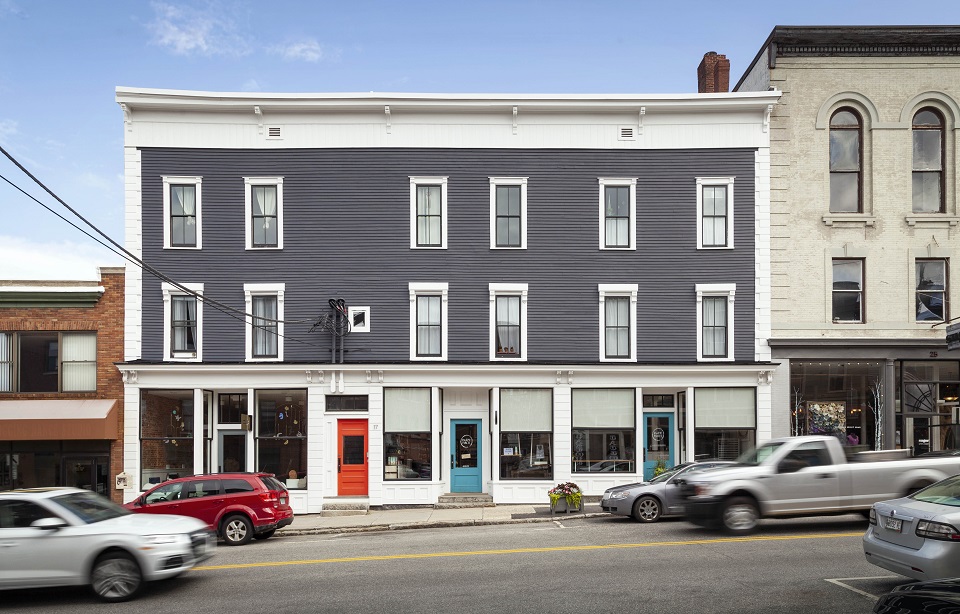News Release

17 Alfred Street store front
News Release Date: October 2, 2019
Contact: NewsMedia@nps.gov
WASHINGTON – According to the Rutgers University’s Center for Urban Policy Research, the Federal Historic Preservation Tax Incentives Program contributed more than $14.4 billion in output in terms of goods and services to the U.S. economy and added $7.4 billion in gross domestic product in Fiscal Year 2018. The program is administered by the National Park Service and the Internal Revenue Service, in partnership with State Historic Preservation Offices.
"Historic preservation tax incentives continue to drive investments in historic preservation and revitalize communities across the country," said National Park Service Deputy Director David Vela. "For more than 41 years, this successful federal/state partnership has enabled the preservation and rehabilitation of more than 44,000 historic properties, while generating more than $176.2 billion in GDP."
The Federal Historic Preservation Tax Incentives Program, commonly known as the Federal Historic Tax Credit program, provides a 20 percent federal tax credit to property owners who undertake a substantial rehabilitation of a historic building in a commercial or other income producing use, while maintaining its historic character.
The National Park Service certifies that a building is historic, and therefore eligible for the program, and that the rehabilitation preserves the building’s historic character; the Internal Revenue Service is then responsible for administering the other aspects of the tax credit under the Internal Revenue Code. The tax incentives program has helped to revive abandoned or underutilized schools, warehouses, factories, churches, retail stores, apartments, hotels, houses, agricultural buildings, offices, and other buildings across the country, and in turn, has helped support the redevelopment of entire downtowns and neighborhoods. It also supports community revitalization, job creation, affordable housing, small businesses, farms, and Main Street development, among other economic benefits.
According to the report, 51 percent of the certified rehabilitation projects were located in low and moderate income areas and more than 75 percent were located in economically distressed areas. Almost half of all projects were less than $1 million in rehabilitation costs and 18 percent were less than $250,000. A quarter of all certified rehabilitation projects were located in communities with a population of less than 50,000 people and 15 percent in communities with a population of less than 25,000 people.
For Fiscal Year 2018, program-related investments created approximately 129,000 jobs, including 46,500 in construction and 28,800 in manufacturing, generating $2.0 billion and $1.3 billion in income respectively. As a result of both direct and multiplier effects, and due to the interconnectedness of the national economy, sectors not immediately associated with historic rehabilitation, such as agriculture, mining, transportation, and public utilities, benefited as well.
State Historic Preservation Offices are the first point of contact for information and guidance for property owners interested in the program, and the National Park Service works closely with them in the administration of the program. A breakdown by state of the economic impacts and other program information is included in the reports.
Fiscal Year 2018 Highlights and Reports
-
Federal Tax Incentives for Rehabilitating Historic Buildings Annual Report for Fiscal Year 2018
-
Annual Report on the Economic Impact of the Federal Historic Tax Credit for Fiscal Year 2018
Case Studies
-
Germania Building (Milwaukee, Wisconsin): The rehabilitation of the Germania is a major milestone for development in the City of Milwaukee and the Central Business District (CBD). The need for additional affordable housing in the CBD and greater downtown area is acute, and the Germania demonstrates that high-quality rehabilitations of historic buildings can help fill this need. By involving unemployed and underemployed city residents to work on the building, the project also created jobs and trained people to start new careers.
-
Cheney High School (Cheney, Washington): School House Lofts’ rehabilitation of the former Cheney High School now provides contemporary and fun living spaces within a cherished historic building and a community icon. It not only provides much-needed student housing at Eastern Washington University, but also reduces automobile use and alleviates parking on-campus, given its close proximity. The project also breathed new life into the vacated high school and supports continuity in the neighborhood by blending a large historic building into a residential section of Cheney (pop. 12,446).
-
17 Alfred Street (Biddeford, Maine): In a city that has long suffered from a significant commercial vacancy rate, 17 Alfred Street has been fully occupied since completion of both the residential and commercial spaces. The entire block is now filled with businesses that complement each other and are starting to bring more people into downtown Biddeford (pop. 21,488). The rehabilitation of 17 Alfred Street is helping fuel Biddeford’s resurgence and is encouraging other downtown building owners to explore historic rehabilitation solutions.
-
Thomson-Lyons Implement Company Building (Crowley, Louisiana): Rehabilitating the Thomson-Lyons Implement Company Building is a vital step in catalyzing more downtown development in Crowley (pop. 12,839). The value of this historic building has significantly increased as a result of its rehabilitation, and the City has invested in public infrastructure, as well as main street events and other amenities, to enhance the appeal of the downtown. Due to the growing downtown appeal, new businesses have started locating in downtown Crowley, and residents are looking for places to remodel in order to live downtown.
Fiscal Year 2018 Highlights
Rehabilitated Housing Units
Rehabilitated new or existing housing units: 19,521
Low and moderate income housing units: 6,152
Economic Benefit
Total estimated rehabilitation investment (Qualified Rehabilitation Expenditures): $6.9 billion
Historic rehabilitation projects certified: 1,805
Estimated total jobs create: 129,000
Output (Goods and Services): $14.4 billion
Gross domestic product: $7.4 billion
Income created: $5.4 billion
Last updated: October 2, 2019
